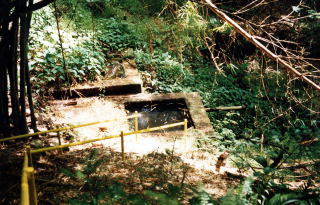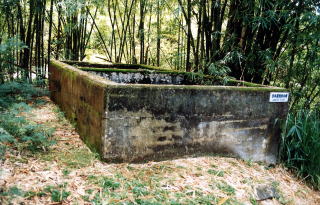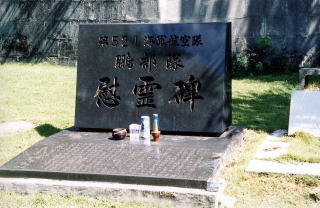
第521海軍航空隊 鵬部隊「慰霊碑」
大宮島(Guam)又木山麓 (Mataguac)第三十一軍司令部跡地付近にある「南太平洋戰没者慰霊公苑」内。
現在の地名は ジーゴ (Yigo)。
Monument of the 521st Air Group of the Imperial Japanese Navy which is located in the South Pacific Memorial Park in Yigo, Guam Island.

第五二一海軍航空隊 鵬部隊は 昭和十八(一九四三)年八月 最新鋭双発急降下爆撃機「銀河」隊をもって開隊され、太平洋戰争の戰局まさに重大化のとき、米機動部隊との一大決戰に備へて全海軍期待のうちに編成された。
十九年四月から逐次 グアムに進出、決戰場をパラオ近海に予測し、飛行機隊はペリリュウ、ハルマヘラに展開したところ、米軍は六月十一日 突如 サイパン グアムに大挙来襲。
わが鵬部隊は劣勢を顧みず、江草隆繁飛行隊長を先頭に死力を尽くして反撃、亀井凱夫司令以下 グアム基地の將兵も又、米上陸部隊に肉弾戰を敢行し、遂に全員散華した。 ここに その勇猛果敢な殉國の死を悼み、これら崇高至純な英霊の精神が恒久世界平和の礎となるよう念願して この碑を建立する。
一九八八年二月 鵬会之建 元第一分隊長 河野 章 撰
碑文全文原文のまま。 事実は碑文の通りでしょう。 軍令部、ならびに 聯合艦隊司令部の誤った敵状判断から 練達の整備兵をグワムに残し、整備の難しい飛行機隊の主力を遠くパラオ方面に移動し、その虚をレイモンド・スプールアンス提督率いる米第五艦隊、マーク・ミッチャー中將の第五十八任務部隊に襲われたのですから 亀井司令ならびに江草飛行隊長のかねてからの錬成の成果を発揮出来なかった憤怒と無念の気持ちが迸っています。 でも もうすべては終はりました。 お陰様で いまや日本の老若善男善女であふれかえる平和な島になりました。 安らかにお眠り下さい。 日本から持参した 清酒と 冨士の清水を めしあがって下さい。 合掌。
| Eulogy on the Monument; |
| The 521st Air Group, OOTORIBUTAI, a group of squadrons of the most advanced
twin-engined dive-bomber of GINGA, was first established in August 1943. While ebbing of the Japanese tide, expectation to the group was so great in an attempt to annihilate US task forces. After finishing training in Japan, the group started to move to the air base in Guam island in April 1944. In an anticipation of the decisive naval battle field in Palaus, air squadrons took up a position scattered around Peleliu and Halmahera. Unexpectedly and suddenly on June 11th, US Task Forces started to attack Saipan and Guam. We at OOTORIBUTAI, though inferior in number, air forces headed by Lt. Commmander Takashige Egusa, made desperate efforts against enemy in Marianas. All land units headed by Captain Yoshio Kamei fought to death against US landed troops in Guam. This monument is founded here to console such brave and valiant sailors who dedicated their lives to the country, and in the aim that their absolutely pure spirits and sublimities may contribute toward an entire World Peace forever. |
| Founded in February 1988 by OOTORIKAI. Epitaph by Akira Kono, ex-Lieutenant, leader pilot, wing No. 1 |
Y-20 GINGA Model P1Y1, Frances
Twin-engined dive-bomber, designed by Commander (technical) Masao Yamana
and developed by Lt. Commander (technical) Tadanao Miki
at Naval Aeronautical Engineering Yard in Yokosuka.
Propelled by 2-HOMARE 12, Model NK9-B double radial 18-cylinder air-cooled engine produces 1,825
PS each at take-off,
designed and developed by Mr. Ryoichi Nakagawa and produced by Nakajima Aircraft Co.
Dr. Yamana, known as designer of carrier-base dive-bomber SUISEI D4Y2, Judy and Rocketeer OHKA MXY-7,
joined Imperial Navy after graduating from the Tokyo Imperial University
majoured in aeronautical engineering in 1929.
In July 1943, he concurrently assumed the post of professor of aeronautical
engineering at his University
and remained the positions until the end of war.
He resumed professor at Tokyo University in 1956 through 1966.
He made tremendous contribution in reaserch and development of aeronutics.
His name became quite wellknown among Japanese people when he resigned
as chairman of the investigation committee
of Boeing 727 crash accident at Haneda in February 1966,
because his view and opinion of cause of crash were not admitted by the
government.
Mr. Miki majoured in shipbuilding engineering at Tokyo Imperial University class of 1933
and entered in Imperial Navy as technical officer.
After the war, he joined Technical Reaserch Labo. of Japan National Railways.
He played significant majour role in developing famous SHINKANSEN, a bullet train betwen Tokyo and Osaka.
Dr. Nakagawa majoured in mechanical engineering at Tokyo Imperial University
class of 1936
and joined Nakajima Aircraft Co.
He was a chief engineer in developing SAKAE double radial 14-cylinder air-cooled engines at age of 23,
that propells the famous Mitsubishi ZERO A6M1fighters.
After the war, for longtime, he acted as chief engineer of engine development
at Prince Motors and Nissan Motor Co.
The first flight of Y-20 Model P1-Y1 was in August 1943.
GINGA is capable to load 800 kgs or 500 kgs bomb, or a torpedo.
1,000 were produced at Nakajima and 100 produced at Kawanishi.

平成十八年五月十日 お参りさせてもらいました。
墓苑はあいかわらず 綺麗に清掃されてゐました。 (2006/05/15 追記)
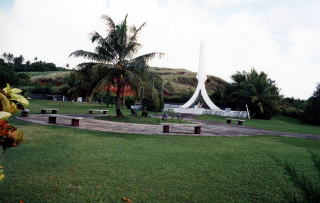
The South Pacific Memorial Park preserves the bunkers of Lt. General Hideyoshi Obata, the CinC of the 31st Army Command of the Imperial Japanese Army, that was attacked on August 11, 1944 by the US 306th Regiment, 77th Army Infantry Division.
「太平洋戰没者慰霊公苑」には鵬部隊慰霊碑の他に 第三十一軍隷下 第十三師団先遣隊、歩兵第十八聯隊、海城 満洲第三四○部隊、独立自動車第二六五部隊、第四気象隊 等 帝國陸海軍の ご遺族の それぞれの惟ひを込めた慰霊碑が建立されている。 ご遺族の方、ご安心下さい。 公苑は綺麗に清掃整備されて 香華の絶へる事はありません。 壹萬九千柱の英霊の御霊よ 安らかに眠り給へ。
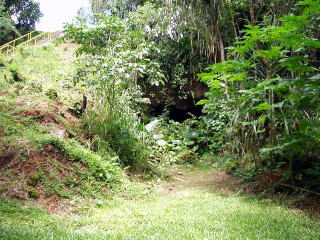

この付近には 横穴壕がたくさんある。 昭和十九年八月十一日 その中の一つで 亀井司令は拳銃を口にくわえてお爺ちゃんの目の前で 副官とともに見事な自決を遂げられたと謂う。 時を同じくして 第三十一軍 軍司令官 小畑英良中將、参謀長 田村義富少將も自決。 その後は 第二十九師團作戰、情報参謀 武田英之中佐が 2500名の陸海軍兵士を掌握して終戰まで北方ならびに南方山中でゲリラ戰を展開したと謂う。
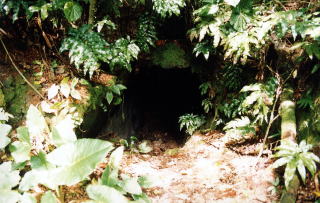
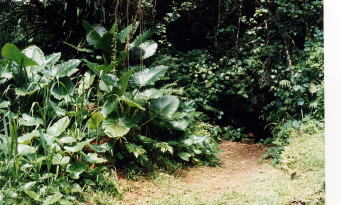
又木山第三十一軍司令部付近の水源池と貯水槽。
付近には日本の眞竹に似た竹藪が生い茂り 日本からの来訪者に話しかけるように「ザワザワ」と風になりながら、小銃の発射音のように「パンパン」と音をたててはじけていた。
